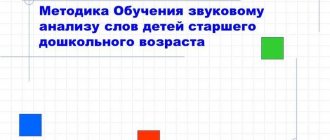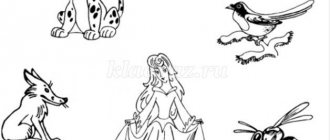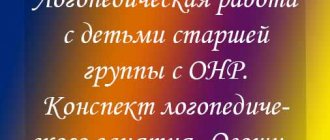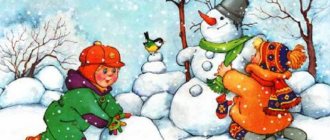Article:
Goal: to develop skills in composing sentences of three or more words.
Tasks:
Educational: teach children to correctly form sentences of three or more words; teach how to distribute proposals; teach how to make sentences using a model; learn how to make your own sentences.
Developmental: skills of grammatical design of sentences and their distribution by adding definitions; develop attention and logical thinking.
Educational: develop skills of organized behavior.
Progress of the lesson:
I Organizational moment.
Articulation gymnastics (Logomer. Set of exercises.)
II Subject message.
— We worked with sentences that consisted of only two words. But a sentence can have three, four, five or more words. Today we will learn how to make sentences of three or more words.
III Study of the topic.
1. “Making three-word sentences based on plot pictures”.
Logomer. Image constructor.
- Look carefully at the picture. (Slide No. 7)
- Who is this? (Girl). What is she doing? (is reading). Let's make a sentence - The girl is reading.
- How many words are in our sentence? (Two) Name the first word: who? - girl - the word is a living object. Name the second word: what is the girl doing? – reads – the second word-word-action.
— What is the girl reading? (Book, newspaper).
Girl reading a book (newspaper)
- What word was added to the sentence? Book (newspaper). How many words are there in the sentence? (Three). Let's outline our proposal.
The following pictures are displayed next. (Slide No. 1) The work is carried out in a similar way.
2. “Making three-word sentences based on two object pictures”.
- Look carefully at the pictures. (Slide No. 8) We see two subject pictures: a boy and a fish).
- Let's try to make a sentence by matching the picture with a word that denotes an action:
The boy catches fish.
— Let’s draw up a diagram of our proposal.
The following pictures are displayed next. (Slide No. 9) The work is carried out in a similar way.
3. “Make three-word sentences with each child”.
Each child is given one story picture and is asked to independently compose a three-word sentence based on it.
4. Physical education minute:
Logomer. A set of exercises for the development of motor skills.
5. “Complicating proposals. Making sentences from four words with adding a definition" .
- Now let's complicate these sentences. (Slide No. 10) For example: The bunny is gnawing on a carrot. Carrots (cabbage,...) what? (Delicious) or: What kind of bunny? Fluffy (small,...), etc..
— Let’s draw up a diagram of our proposal.
The following pictures are displayed next. (Slide No. 11) The work is carried out in a similar way.
6. Exercise “Assemble a sentence from words .
- And now I will tell you the words, and you listen to them carefully and collect sentences from them.
Example: Ball, Tanya, catch, big. – Tanya catches a big ball.
- Sweater, mom, knit, beautiful. (Mom knitted a beautiful sweater)
- Fish, fishermen, catch, big. (The fishermen caught a big fish)
- The book, Katya, is interesting to read. (Katya is reading an interesting book)
- Dragonfly, Rita, see, it’s big. (Rita saw a big dragonfly)
— Bun, Vova, buy it, delicious. (Vova bought a delicious bun)
- Children draw with pencils, colored ones. (Children draw with colored pencils)
— Tree, storm, broken, old. (The storm broke the old tree).
IV. Result:
- You did great today! We did very well.
- What new did you learn? What did you like most?
Speech therapist lesson - text and sentence
Subject: Text. Offer.
Purpose: To give the concepts of text and sentences, to consolidate them with practical material.
Tasks:
- Teach children to determine the boundaries of a sentence.
- Clarify the rules for writing a sentence.
- Develop auditory and visual perception.
- Develop the articulatory apparatus to improve the clarity of pronunciation.
- Develop attention and memory.
- Cultivate linguistic observation and love for the native language.
Equipment: presentation “Text. Offer."
Order the original presentation: This e-mail address is being protected from spambots. You need JavaScript enabled to view it.
All presentations here
Progress of the lesson
I. Org. moment and articulatory gymnastics (learning 3-5 exercises) (slide 2)
II. Explanation of new material. (slide 3)
Vovochka will help us learn to read and write. Vovochka did his homework, but he didn’t know what a text and a sentence were. - Text... Sentence... - muttered Vovochka - What are you saying? - asked the Cat. - Now I will explain everything to you. Listen to these beautiful words: text... sentence... Look at the picture and answer the questions. (slide 4) Children look at the picture
Cat: - What time of year is shown in the picture?
- What day was it? -Where did the wolf come? -Who did he see in the house? - What did the wolf start doing? - What did we make up? - Story. — A story can be called a text in another way; a text is a story, a fairy tale, and a poem. - Let's repeat this word in chorus: - Text. — What did each of you say when answering the questions? - ... - Can each of your answers be called a story-text? -... - Each of you spoke only part of the text, which is called a sentence. (slide 5) - To help you remember these words better, an old friend will come to my aid. Guess who?
The girlfriends are different in height, But they look alike, They all sit next to each other, And there is only one girlfriend. (matryoshka) (mouse click) - The matryoshka is similar to the text in that it consists of other nesting dolls hidden inside it. And the text also contains other components, parts. (Matryoshka appears - text and sentence) (slide 6)
Physical exercise.
Text-sentence game (slide 7) - If I say “text”, spread your arms wide to the sides, if I say “sentence” - jump in place. How can we find out how many parts - sentences there are in the text? - ... - This can be recognized by small stops - pauses. They are made where one sentence ends and another begins.
— So that you can tell the story about the wolf and the seven kids to your parents, let’s write it down, but not in letters. You don’t know how to write yet, so you will mark each sentence with a corner with a dot instead of a pause. (Sentence writing rule: Capital letter at the beginning, period at the end.)
Open the workbooks. And now we begin to work with me. Let's learn the rule. A text is several sentences interconnected in meaning. I repeat the text, and you count how many pauses and stops you will hear... (slide 
- Now draw as many corners as you counted sentences. The work is carried out in parallel by the teacher on the blackboard and by the children in workbooks. Bottom line. (slide 9) - What does the text consist of? — How to determine that a sentence has ended in oral, colloquial speech? — How can you tell in a letter that a sentence has ended? - How can you determine that a new sentence has begun?
Well done!
Author of the material: Gavrilova Evgenia Vladimirovna
Also on topic:
Summary of a lesson on speech correction for children with special needs on the topic “Sentence”






